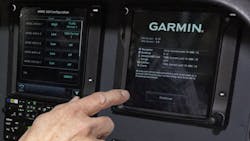How many cellphones have you traded in, sold or simply recycled in the past 20 years? For early adopters, it could be 10 or more if you take advantage of the upgrades afforded by carriers. The current national average for a phone upgrade is every 32 months, increasing from cycles that were initially as low as every 12 to 18 months. How about your iPad or tablet? Not quite as many, but still a few upgrades over the last decade, right? When you consider the rapid changes taking place in the consumer electronics market and see the advances in the aircraft electronics market, it’s easy to assume there are parallels in the upgrade cycles. Arguably, the ability to lose a phone, have it stolen or broken beyond repair changes the usual upgrade cycle and skews a proper comparison. But the expense of new handsets and their vastly improved technical specifications are elongating the upgrade lifecycle. Are there parallels to the aircraft electronics (avionics) industry? Like cellphones, do aircraft owners and pilots hold onto their equipment longer to enjoy operating system upgrades, user interface improvements and to simply save money — certainly as long as the hardware keeps up, right? With software becoming the new maintenance, it’s not just changing consumer electronics, it’s changing aircraft electronics and how some avionics shops and equipment manufacturers support their products.
The bench repair business may not comprise the same portion of a repair station’s operations as it did 20 or 30 years ago, but it is a convenience for customers and a nice complement to a business when installations are not as backlogged. Many Aircraft Electronics Association (AEA) member shops, government-certified maintenance organizations, still support their customers and other shops with bench work and in-house support of decades-old equipment. For those with the expertise, a competitive advantage exists over the shop that must send something back to the manufacturer or another dedicated repair facility. For the fundamentals, the AEA even offers a training course at our headquarters facility, Bench Basics, where students fabricate a general-purpose test panel then use it to perform common Nav/Comm and transponder checks. There is no denying that avionics installations are the primary focus for many of our shops and the bench business has changed. While the ESD smocks have been traded for workwear better suited for the hangar and flight line, there still exists a considerable market for the experts equipped with the right test equipment and technical experience to troubleshoot and repair legacy instruments and electronics.
It’s Not Just “Out with the Old”
New technologies aren’t leaving legacy products completely behind. Just as a new battery, a new screen or even an operating system update can breathe life back into your cellphone, the same can be said for previous-generation avionics. As the aviation market changes with the addition of glass and electronic gauges, customers still have several options for their gyros, gauges and avionics. The question of “should I upgrade or get my instruments repaired?” is common at Mid-Continent Instrument and Avionics. For them, the answer is easy. With the ability to repair units to the highest quality, the question is more about the cost-benefit analysis for the customer. With the modernization of electronic instruments versus gyroscopic instruments the last few years, there are a myriad of options available that make the upgrade decision more compelling. Controlling the costs of repair and maintaining the highest levels of quality are ways to ensure customers can justify their decision to stay with legacy products.
For avionics repairs like Nav/Comms, autopilots and autopilot accessories, business has increased as customers just aren’t ready to depart with their older avionics. Service parts availability can be an issue on older products and have become harder to find. Most of these products are the older ARC, Century Flight Systems and Bendix products. But even with hard-to-find parts, there is still an ability to repair the units. Every year for the past 30 years of his employment at Mid-Continent Instruments and Avionics, Bruce Grammon, technical sales representative, would say, “I bet we won’t be working on some of these products next year,” and every year they still find those units in the repair queue.
Experience is what keeps legacy product repairs and support going. And companies like Mid-Continent Instruments and Avionics have been fortunate to keep technicians with an average of 25 years of experience. Grammon noted his team discusses legacy repairs daily and the challenges needed to overcome to keep the products in aircraft. With the addition of the BendixKing partnership, it has given new life to be able to repair a variety of avionics equipment. Grammon speaks to customers daily who are not looking to upgrade and prefer the products they currently have in the aircraft. All they want is to find someone to help them. Growth in this business at Mid-Continent Instruments and Avionics can be credited to customers calling to get their avionics repaired while other avionics shops focus on new installs and even fewer shops still performing bench work.
To understand the magnitude of this market for legacy equipment, look no further than the AEA’s EEDirect, a members-only exchange for used avionics. Any one of the AEA’s nearly 1,000 repair station companies have access to 27,000 line replaceable units available on the shelves of their fellow members. This inventory is updated monthly by more than 250 regular participants in the exchange. The listing provides dealers with a “Blue Book” price, which helps shops determine trade-in values for their customers installing and upgrading the latest and greatest. In a way, it’s like any other online selling site except you have trusted partners — fellow members — in the marketplace buying and selling the used equipment in order to help their end customers. These aircraft owners and pilots may be upgrading and looking for some trade-in credit with their existing panel or trying to save a little money buying used equipment or last-generation technology that still has life in it.
“In with the New”
As consumer or aircraft electronic systems gain in complexity, processing power and capability, the desire to have the latest and greatest will attract the early adopters and continue to create a secondary market for some used equipment. Upgrading avionics brings with it the same modern conveniences consumers see when upgrading their personal electronics. Improved mean time between failure (MTBF), advanced diagnostics and troubleshooting with direct technical support make feature-rich modern avionics systems safer, more convenient and more consistent in their operation. These luxuries come with more contemporary support methods to ensure a customer’s peace of mind but don’t completely eliminate the challenges of maintaining system updates, proper configuration settings and successful system integration.
According to the Garmin product support team, software, configuration and data logging have become increasingly important and one of the key starting points for troubleshooting almost any avionics field issue. Data logging allows support and engineering the ability to see trends or pinpoint particular issues during a flight and reduce the time needed to troubleshoot the equipment or the system. The transition to line replaceable units and advancements in onboard diagnostics have also made it easier to quickly identify and fix problems. Most factory troubleshooting assistance can now be provided remotely as a result.
The support team at Universal Avionics led by Robert Clare, director of customer services, also uses remote connections to support software loading and diagnostics. In the company’s flagship glass cockpit product, InSight, a remote software load was required in support of a newly outfitted Hawker 800XP. The aircraft was 6,000 miles away, and with travel restrictions due to the pandemic, access to the aircraft was impractical. The ability to remotely connect and load software saved 10 or more days of aircraft downtime that would have resulted in the dealer needing to ship the equipment from Argentina to UA’s repair station in Tucson, AZ, and for UA to ship the equipment back for final installation. This capability provides extensive possibilities for Universal Avionics, its network of dealers and the end customer. Clare noted that with glass cockpits, digital communications and the reduction of antiquated analog instruments, troubleshooting can be fast and simplified as there are less wires to ring and more sophisticated internal diagnostics. All of the company’s current products have a level of digital troubleshooting that is quick and effective with the tools that are used by its field service engineers.
Making this all happen are the skilled technicians who regularly receive technical and OEM product-specific training to maintain their currency and prove they are capable of performing their assigned task. For repair stations, this is a regulatory requirement. According to the Garmin product support team, in today’s era of increased integration and system architectures that are tied more and more to engine and airframe systems, the complexity requires even broader maintenance skillsets and training requirements. They added that the advent of wireless connectivity between mobile devices and installed systems has created another needed skillset for avionics technicians. Being able to connect properly and sequence through the troubleshooting or maintenance procedures is critical to the speed and efficacy of these new methods. Fortunately, with the outstanding support from avionics OEMs and the fundamental industry training provided by the AEA, today’s avionics technology experts are equally capable of maintaining the aging systems as well as supporting the modern systems and ultimately helping customers with their upgrade lifecycles.
Mike Adamson, AEA President & CEO
An accomplished and experienced association executive, Mike Adamson leads the Aircraft Electronics Association as president and chief executive officer from its international headquarters in Lee's Summit, MO. The AEA represents nearly 1,300 member companies in more than 40 countries, including avionics manufacturers and government-certified international repair stations specializing in maintenance, repair and installation of avionics and electronic systems in general aviation aircraft.

